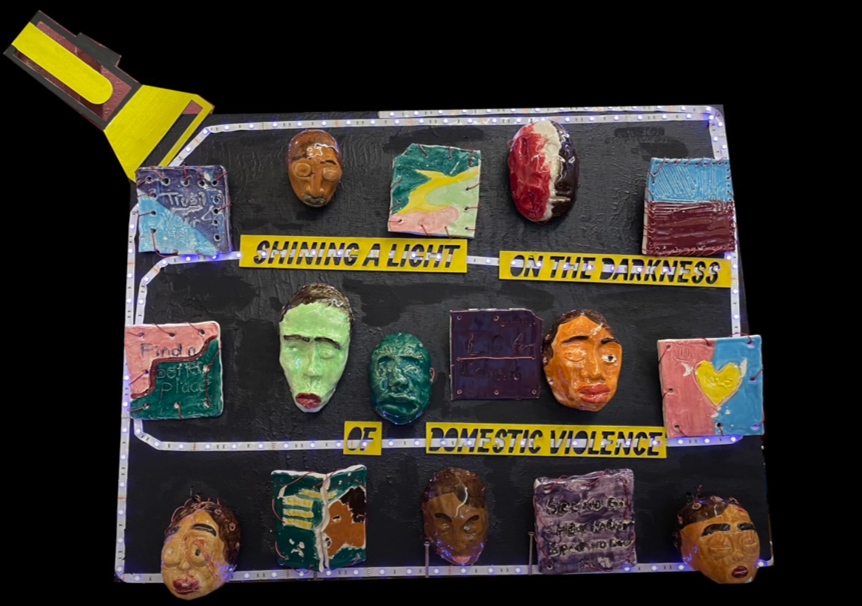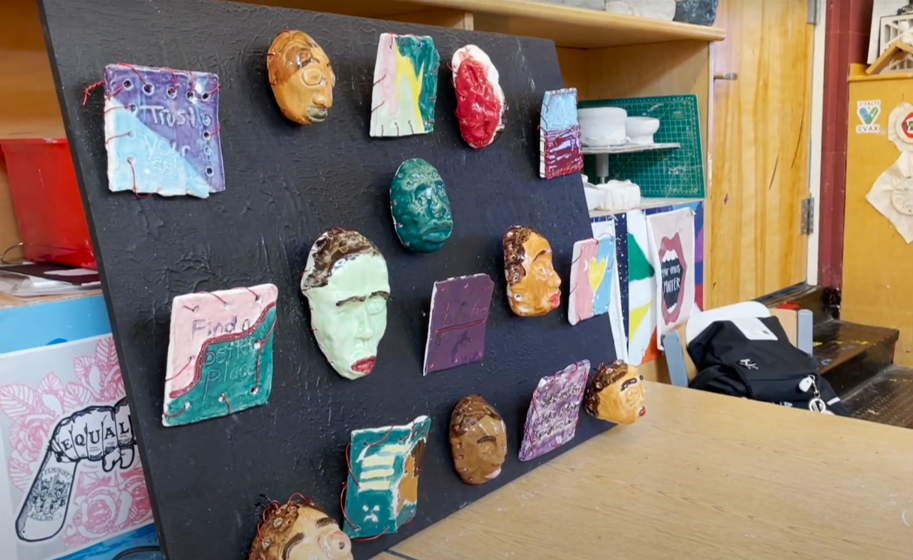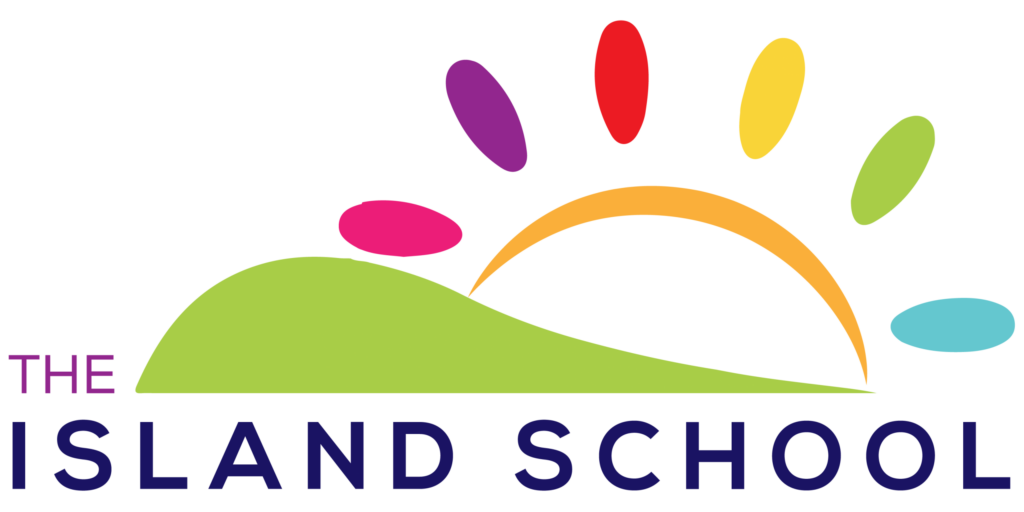PS/MS 188 The Island School, Lower East Side, Manhattan, NYC
SENSITIVE CONTENT WARNING: This video contains discussions about educating to prevent domestic violence. The topic may be upsetting for some viewers.
Case Study – The Social Action Makerspace
Run by: Dr Lou Lahana at PS/MS 188 The Island School, Lower East Side, Manhattan, NYC

Through its Full Service Community School Model PS/MS 188 The Island School is committed to providing the resources and services children need to succeed academically and to help families thrive. The Island School uses a Schoolwide Enrichment Model to enact its philosophy of passion-based learning, where students learn best when they are given choice as to the themes and tools they use to explore our world. The school’s Social Action Makerspace encourages students to pursue independent investigations of real world-problems so they can become problem-solvers and social activists in their community.
The case study was chosen for two reasons: i) its Community School model and ii) its passion-based approach to learning in The Social Action Makerspace.
What is a Community School?
The NYC Community School Model was developed by the then Mayor Bill de Blasio in 2014 as part of his ‘people-powered’ approach to education. 45 schools became NYC Community Schools as part of an attendance-improvement and drop-out-prevention project. In the school year 2022-23 there are 421 Community Schools across every district in NYC.
PS/MS 188 The Island School is a Full Service Community School for students from 3K (age 3) to 8th grade (age 13-14). The school is located on the Lower East Side of Manhattan between two public housing complexes and across the street from The Urban Family Center, a temporary housing facility. Enrollment has disproportionately high representation of students most at-risk of dropping out of school.
As a Full-Service Community School, PS/MS 188 The Island School is a one-stop service centre for children, families and alumni students, offering the following services: nutrition, counselling, mental health, medical, health & wellness, social service support, parent development programmes, computer/internet access as well as extended day, vacation and summer programmes.
What is the Social Action Makerspace?
Dr Lou Lahana (The ‘Techbrarian’) is the Social Action Makerspace Coordinator. Through the Social Action Makerspace Lou sets out to spark and fuel students’ passions and apply it using physical and digital materials instead of books.
The Makerspace focuses on issues of equity and social activism, supporting students to become problem-solvers and social activists in their community. The Social Action Makerspace gives students choice as to the themes and tools they use to explore our world. Students self-select a social issue that concerns them and use a variety of low and high-tech tools to raise awareness and develop solutions to help solve the problems.

New York City Young People’s Project: Shining a Light on the Darkness of Domestic Violence (ceramic piece and short film)
The students working on this project were from middle school (MS188), grades (years) 6-8. As part of the school’s curriculum, students have lessons in the school’s Social Action Makerspace, where they use a range of high tech and low tech creative resources to conduct investigations of real-world problems that matter to them and to develop and publicly share their ideas for solutions.
Darshany, Exauce, Jacob, Krystle and Simaya chose domestic violence as the most important topic for them in terms of education for a fairer place. The students and their teacher, Dr Lou Lahana, had been inspired by the work of the visual artist Aisha Tandiwe Bell and were lucky enough to be able to work with Aisha in the school’s Social Action Makerspace. Aisha ran a series of workshops for students and parents, where they were able to develop their skills in ceramics and to bring their message on how education can help make New York City a fairer place to live.
In the short film, Darshany, Exauce, Jacob, Krystle and Simaya from PS/MS188 The Island School discuss the creation of their ceramic piece, Shining a Light on the Darkness of Domestic Violence. They explain why education to prevent domestic violence is vital if New York (and other cities) are to be safer, fairer places for all citizens.
The film explains the creative artistic process and the important messages of the final ceramic piece, Shining a Light on the Darkness of Domestic Violence. Darshany, Exauce, Jacob, Krystle and Simaya were joined by parents in the creation of their artwork, some of whom are community activists against domestic violence and founders of the nonprofit organisation, Returning Hope, who work towards empowering survivors and educating the next generation on domestic violence.
School: PS/MS 188 The Island School, Lower East Side, Manhattan, NYC
Students: Darshany, Exauce, Jacob, Krystle, Simaya
Teacher: Lou Lahana
Artist: Aisha Tandiwe Bell
Returning Hope: Angelina Rosado, Founder and Chief Executive Officer. Returning Hope is a nonprofit organization dedicated towards empowering survivors and educating the next generation on domestic violence.
Video
Overview of the city
An Inclusive Economy
In 2016 New York was one of the cities to establish and sign the OECD’s The New York Proposal for Inclusive Growth in Cities:
“Inclusive Growth calls for a major break with the policy making of the past. This means reassessing the way in which we design our policies to ensure that growth and equity are treated as mutually reinforcing goals, as well as putting well-being and social inclusion at the centre of the debate on economic growth.
Cities have a crucial role to play in making inclusive growth happen. Cities are key actors in many domains that matter for inclusive growth, including education, health care services, social protection, training and employment services, as well as housing, neighbourhood regeneration and transport.”
In 2023, NYC developed a new strategy for an inclusive economy, focused on workforce development and more equitable distribution of prosperity.
Pathways to an Inclusive Economy intends to ‘overhaul New York City’s historically fragmented and siloed approach to talent and workforce development with a set of proposed “Strategic Levers” that can help lift New York City to become more inclusive and more prosperous.
“For the first time, we set clear responsibilities for job training and employment services within City government, and named a series of priority objectives. City residents should be on track for economically secure careers by age 25, working New Yorkers should earn a living wage, local employers should have access to the local talent they need to thrive, and data should show progress in tackling historic disparities in employment.”
Education and schooling in New York City
“The New York City Department of Education (DOE) overlooks public schooling throughout New York City, this department establishes the standards of education provided alongside a variety of regulations and safe guarding procedures. The schooling system in New York City begins in “early childhood”, allowing students to then graduate in “Grade 12”. NYC DOE website.” – NYC Public Schools (2023)
“Beginning in fall 2014, 45 schools became NYC Community Schools as part of an attendance-improvement and drop-out-prevention grant in partnership with United Way NYC. In School Year 2022-23 there are 421 Community Schools across every district in NYC, funded through city, state and federal dollars.
Community Schools support:
- the whole child
- the child’s family
- learning both inside and outside of the classroom” – NYC Community Schools

